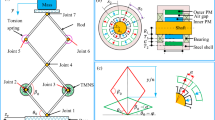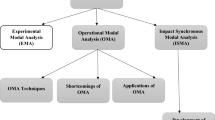Abstract
Multi-shaker vibration testing is gaining interest from structural dynamics test engineers as it can provide a much more accurate match to complicated field vibration responses than traditional single-axis shaker tests. However, the force capabilities of the small modal shakers typically used in multi-shaker vibration tests has limited the achievable response levels. To date, most multi-shaker vibration tests have been performed using a variety of standard, commercially-available control systems. While these control systems are adequate for a wide range of multiple-input/multiple-output tests, their control algorithms have not been tailored for the specific problem of multi-shaker vibration tests: efficiently coordinating the various shakers to work together to achieve a desired response. Here, a new input estimation algorithm is developed and demonstrated using simulations and actual test data. This algorithm, dubbed shape-constrained input estimation, is shown to effectively coordinate multiple shakers using a set of constraint vectors based on the deflection shapes of the test structure. This is accomplished by using the singular vector shapes of the system frequency response matrix, which allows the constraint vectors to automatically change as a function of frequency. Simulation and test results indicate a significant reduction in the input forces required to achieve a desired response. The results indicate that shape-constrained input estimation is an effective method to achieve higher response levels from limited shaker forces which will enable higher level multi-shaker vibration tests to be performed.




















Similar content being viewed by others
References
Daborn PM (2017) Scaling up of the Impedance-Matched Multi-Axis Test (IMMAT) technique. In: Proceedings of the 35th International Modal Analysis Conference (IMAC XXXV), Garden Grove, CA
Daborn PM, Ind PR, Ewins DJ (2013) Replicating aerodynamic excitation in the laboratory. In: Proceedings of the 31st International Modal Analysis Conference (IMACXXXI), Garden Grove
Mayes RL, Rohe DP (2016) Physical vibration simulation of an acoustic environment with six shakers on an industrial structure. In: Proceedings of the 34th International Modal Analysis Conference (IMACXXXIV), Orlando
Roberts C, Ewins DJ (2018) Multi-axis vibration testing of an aerodynamically excited structure. J Vib Control 24(2):427–437
Underwood MA, Hale M (2008) MIMO Testing Methodologies. In: Proceedings of the 79th shock and vibration symposium, Orlando
Daborn PM, Roberts C, Ewins DJ, Ind PR (2014) Next-generation random vibration tests. In: The 32nd International Modal Analysis Conference (IMAC XXXII), Orlando, FL
Rohe DP, Nelson GD, Schultz R (2019) Strategies for shaker placement for impedance-matched multi-axis testing. In: Proceedings of the 37th International Modal Analysis Conference (IMAC XXXVII), Orlando
Daborn PM (2014) Smarter dynamic testing of critical structures. PhD Thesis, University of Bristol
Smallwood DO (2010) A proposed method to generate a spectral density matrix for a Multiple Input, Multiple Output (MIMO) vibration test. In: Proceedings of the 81st shock and vibration symposium, Orlando
Wright JR, Cooper JE, Desforges MJ (1999) Normal-mode force appropriation - theory and application. Mech Syst Signal Pr 12(2):217–240
van Karsen CD, Wittrup KP, DeClerck JP (1996) The application of stepped sine and normal mode testing to automotive structures. In: Proceedings of the 14th International Modal Analysis Conference (IMACXIV), Dearborn
Fahnline JB, Campbell RL, Hambrick SA, Shepherd MR (2017) Modal analysis using the singular value decomposition and rational fraction polynomials. In: The Applied Research Laboratory, the Pennsylvania State University, State College, PA
Hansen PC (2010) Discrete inverse problems: insight and algorithms. In: SIAM: The Society for Industrial and Applied Mathematics, University of Auckland, Auckland
Choi HG, Thite AN, Thompson DJ (2007) Comparison of methods for parameter selection in tikhonov regularization with applicate to inverse force determination. J Sound Vib 304:894–917
Schultz R (2019) A demonstration of force estimation and regularization methods for multi-shaker testing. In: Proceedings of the 37th International Modal Analysis Conference (IMAC XXXVII), Orlando
Jacobsen F (1979) The diffuse sound field. In: Acoustics Laboratory at the Technical University of Denmark, Lyngby
Kuster M (2008) Spatial correlation and coherence in reverberant acoustic fields: extension to microphones with arbitrary first-order directivity. J Acoust Soc Am 123(1):154-162
Kammer DC (1991) Sensor placement for on-orbit modal identification and correlation of large space structures. J Guid Control Dynam 14(2):251–259
Smallwood DO (1978) Multiple shaker random control with cross coupling. In: Proceedings of the Institute of Environmental Sciences, Mt. Prospect
Smallwood DO, Paez TL (1991) A frequency domain method for the generation of partially coherent normal stationary time domain signals. Shock Vib 1(1). https://doi.org/10.3233/SAV-1993-1106
Schultz R, Nelson GD (2019) Input signal synthesis for open-loop multiple-input/multiple-output testing. In: Proceedings of the 37th International Modal Analysis Conference (IMAC XXXVII), Orlando
Acknowledgements
Sandia National Laboratories is a multimission laboratory managed and operated by National Technology & Engineering Solutions of Sandia, LLC, a wholly owned subsidiary of Honeywell International Inc., for the U.S. Department of Energy’s National Nuclear Security Administration under contract DE-NA0003525. This paper describes objective technical results and analysis. Any subjective views or opinions that might be expressed in the paper do not necessarily represent the views of the U.S. Department of Energy or the United States Government.
Author information
Authors and Affiliations
Corresponding author
Ethics declarations
On behalf of all authors, the corresponding author states that there is no conflict of interest.
Additional information
Publisher’s Note
Springer Nature remains neutral with regard to jurisdictional claims in published maps and institutional affiliations.
Rights and permissions
About this article
Cite this article
Schultz, R., Avitabile, P. Shape-constrained Input Estimation for Efficient Multi-shaker Vibration Testing. Exp Tech 44, 409–423 (2020). https://doi.org/10.1007/s40799-020-00361-0
Received:
Accepted:
Published:
Issue Date:
DOI: https://doi.org/10.1007/s40799-020-00361-0




